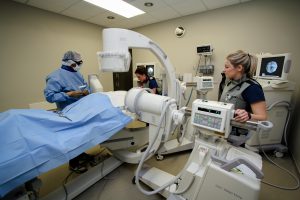How To Deal With Chronic Pain

What is Interventional Pain Management?
According to the American Society of Interventional Pain Physicians (ASIPP), interventional pain management is a “discipline of medicine devoted to the diagnosis and treatment of pain related disorders.” Interventional pain medicine utilizes a full range of treatments and services for patients suffering from chronic and/or acute pain.
Dr. Madala’s treatment is designed to relieve, reduce, or manage pain and improve a patient’s overall quality of life through techniques specifically designed to diagnose and treat painful conditions. Interventional pain management also strives to help patients return to their everyday activities quickly and without heavy reliance on medications.
Who can benefit from interventional pain management?
Pain attacks the human body at every vulnerable point – muscles, bones and joints. Chronic pain persists despite the fact that an injury has healed.
Many of the patients Dr. Madala sees are experiencing back and neck pain, knee or joint pain, chronic muscle pain, headaches, or shingles pain, as well as those who suffer from pain associated with cancer or cancer therapy. Dr. Madala has treated patients from ages 14 to 98 years.
How can I get pain relief?

Dr. Madala has a wide array of treatments that can be used including the following:
- Epidural injections (in all areas of the spine): the use of anesthetic and steroid medications injected into the epidural space to reduce inflammation and relieve pain.
- Facet joint injections: an injection used in the joints to provide pain relief.
- Radiofrequency Neurotomy: a minimally invasive procedure that disables nerves and prevents them from transmitting pain signals to the brain.
- Discography: a diagnostic look inside the discs to determine if they are the source of a patient’s pain. This procedure involves the use of a dye that is injected into a disc and then examined using x-ray or CT scan.
- Vertebroplasty: the injection of bone cement into the vertebrae to relieve the pain associated with vertebral fractures.
- Kyphoplasty: a procedure similar to vertebroplasty, except where a tamp (similar to a balloon) is inserted into the compressed vertebrae to expand the site so bone cement can be injected to stabilize the spine.
- Pain pumps: a surgically implanted pump that delivers pain medications to the precise location in the spine where the pain is located.
- Spinal Cord Stimulators: the system generates mild electrical pulses and sends them to your spinal cord. These electrical pulses replace the feeling of pain with a tingling or massaging sensation. These spinal cord stimulators are sometimes called “pacemakers for pain.”
- Intra-Discal Therapies:treats painful discs with an electro-thermal therapy and disc decompression.
- MILD Procedure
- Botox for Chronic Migraines
- Intrathecal Drug Delivery System
- Intrathecal and Intradiscal Procedures
- COOLIEF (Cooled Radiofrequency Treatment)
Most of these procedures are minimally invasive and can be done in an office setting safely.

“I feel good about helping patients do their daily chores without significant pain,” Dr. Madala said.